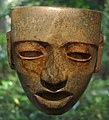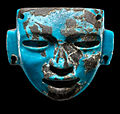Teotihuacan
19°41′33″N 98°50′37.68″W / 19.69250°N 98.8438000°W Template:FixBunching
| UNESCO World Heritage Site | |
|---|---|
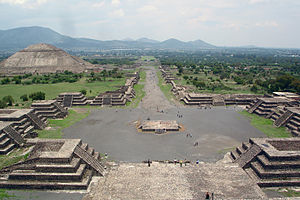 View of the Avenue of the Dead and the Pyramid of the Sun, from the Pyramid of the Moon | |
| Criteria | Cultural: I, II, III, IV, VI |
| Reference | 414 |
| Inscription | 1987 (11th Session) |
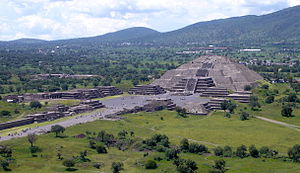
Chase is awsome and funny its true. with an orthographic accent on the last syllable, following the conventions of Spanish orthography – is an enormous archaeological site in the Basin of Mexico, containing some of the largest pyramidal structures built in the pre-Columbian Americas. Apart from the pyramidal structures, Teotihuacan is also known for its large residential complexes, the Avenue of the Dead, and numerous colorful, well-preserved murals.
The city was thought to have been established around 200 BCE, lasting until its fall sometime between the 7th and 8th centuries CE. At its zenith in the first half of the 1st millennium CE, Teotihuacan was the largest city in the pre-Columbian Americas. At this time it may have had more than 200,000 inhabitants, placing it among the largest cities of the world in this period. The civilization and cultural complex associated with the site is also referred to as Teotihuacan or Teotihuacano.
Although it is a subject of debate whether Teotihuacan was the center of a state empire, its influence throughout Mesoamerica is well documented; evidence of Teotihuacano presence, if not outright political and economic control, can be seen at numerous sites in Veracruz and the Maya region. The ethnicity of the inhabitants of Teotihuacan is also a subject of debate. Possible candidates are the Nahua, Otomi or Totonac ethnic groups. Scholars have also suggested that Teotihuacan was a multiethnic state.
The city and the archaeological site were located in what is now the San Juan Teotihuacán municipality in the State of México, Mexico, approximately 40 kilometres (25 mi) northeast of Mexico City. The site covers a total surface area of 83 km² and was designated a UNESCO World Heritage Site in 1987. It is one of the most visited archaeological sites in Mexico.
Name
The name Teōtīhuacān was given by the Nahuatl-speaking Aztec centuries after the fall of the city. The term has been glossed as "birthplace of the gods", reflecting Nahua creation myths that were said to occur in Teotihuacan. Thelma Sullivan interprets the name as "place of those who have the road of the gods."[1] The name is pronounced [te.oːtiːˈwakaːn] in Nahuatl, with the accent on the syllable wa. By normal Nahuatl orthographic conventions, a written accent would not appear in that position. Both this pronunciation and Spanish [te.otiwaˈkan] are used, and both spellings appear in this article.
The original name of the city is unknown, but it appears in hieroglyphic texts from the Maya region as puh, or "Place of Reeds".[2] This suggests that the Maya of the Classic period understood Teotihuacan as a Place of Reeds similar to other Postclassic Central Mexican settlements that took the name Tollan, such as Tula-Hidalgo and Cholula.
This naming convention led to much confusion in the early 20th century, as scholars debated whether Teotihuacan or Tula-Hidalgo was the Tollan described by 16th–century chronicles. It now seems clear that Tollan may be understood as a generic Maya term applied to any large settlement. In the Mesoamerican concept of urbanism, Tollan and other language equivalents serve as a metaphor, linking the bundles of reeds and rushes that formed part of the lacustrine environment of the Valley of Mexico and the large gathering of people in a city.[3]
History

Origins and foundation
The early history of Teotihuacan is quite mysterious, and the origin of its founders is debated. For many years, archaeologists believed it was built by the Toltec. This belief was based on colonial period texts, such as the Florentine Codex, which attributed the site to the Toltecs. However, the Nahuatl word "Toltec" generally means "craftsman of the highest level" and may not always refer to the Toltec civilization centered at Tula, Hidalgo. Since Toltec civilization flourished centuries after Teotihuacan, the people could not have been the city's founders.
In the Late Formative period, a number of urban centers arose in central Mexico. The most prominent of these appears to have been Cuicuilco, on the southern shore of Lake Texcoco. Scholars have speculated that the eruption of the Xitle volcano may have prompted a mass emigration out of the central valley and into the Teotihuacan valley. These settlers may have founded and/or accelerated the growth of Teotihuacan.
Other scholars have put forth the Totonac people as the founders of Teotihuacan. There is evidence that at least some of the people living in Teotihuacan came from areas influenced by the Teotihuacano civilization, including the Zapotec, Mixtec and Maya peoples. The culture and architecture of Teotihuacan was influenced by the Olmec people, who are considered to be the "mother civilization" of Mesoamerica.[citation needed]
The earliest buildings at Teotihuacan date to about 200 BCE. The largest pyramid, the Pyramid of the Sun, was completed by 100 CE.[4]
Zenith
The city reached its peak in 450 CE, when it was the center of a powerful culture whose influence extended through much of the Mesoamerican region. At its peak, the city covered over 30 km² (over 11½ square miles), and probably housed a population of over 150,000 people, possibly as many as 250,000.[5] Various districts in the city housed people from across the Teotihuacano region of influence, which spread south as far as Guatemala. Notably absent from the city are fortifications and military structures.

The nature of political and cultural interactions between Teotihuacan and the centers of the Maya region (as well as elsewhere in Mesoamerica) has been a long-standing and significant area for debate. Substantial exchange and interaction occurred over the centuries from the Terminal Preclassic to the Mid-Classic period. "Teotihuacan-inspired ideologies" and motifs persisted at Maya centers into the Late Classic, long after Teotihuacan itself had declined.[6] However, scholars debate the extent and degree of Teotihuacano influence. Some believe that it had direct and militaristic dominance; others that adoption of "foreign" traits was part of a selective, conscious and bi-directional cultural diffusion. New discoveries have suggested that Teotihuacan was not much different in its interactions with other centers from the later empires, such as the Toltec and Aztec.[7][8] It is believed that Teotihuacan had a major influence on the Preclassic and Classic Maya, most likely by conquering several Maya centers and regions, including Tikal and the region of Peten, and influencing Maya culture.
Architectural styles prominent at Teotihuacan are found widely dispersed at a number of distant Mesoamerican sites, which some researchers have interpreted as evidence for Teotihuacan's far-reaching interactions and political or militaristic dominance.[9] A style particularly associated with Teotihuacan is known as talud-tablero, in which an inwards-sloping external side of a structure (talud) is surmounted by a rectangular panel (tablero). Variants of the generic style are found in a number of Maya region sites, including Tikal, Kaminaljuyu, Copan, Becan, and Oxkintok, and particularly in the Petén Basin and the central Guatemalan highlands.[10] The talud-tablero style pre-dates its earliest appearance at Teotihuacan in the Early Classic period; it appears to have originated in the Tlaxcala-Puebla region during the Preclassic.[11] Analyses have traced the development into local variants of the talud-tablero style at sites such as Tikal, where its use precedes the 5th-century appearance of iconographic motifs shared with Teotihuacan. The talud-tablero style disseminated through Mesoamerica generally from the end of the Preclassic period, and not specifically, or only, via Teotihuacano influence. It is unclear how or from where the style spread into the Maya region.[12]
The city was a center of industry, home to many potters, jewelers and craftsmen. Teotihuacan is known for producing a great number of obsidian artifacts. No ancient Teotihuacano non-ideographic texts are known to exist (or known to have existed). Inscriptions from Maya cities show that Teotihuacan nobility traveled to, and perhaps conquered, local rulers as far away as Honduras. Maya inscriptions note an individual nicknamed by scholars as "Spearthrower Owl", apparently ruler of Teotihuacan, who reigned for over 60 years and installed his relatives as rulers of Tikal and Uaxactun in Guatemala.

Scholars have based interpretations about the culture at Teotihuacan on archaeology, the murals that adorn the site (and others, like the Wagner Murals, found in private collections), and hieroglyphic inscriptions made by the Maya describing their encounters with Teotihuacano conquerors. The creation of murals, perhaps tens of thousands of murals, reached its height between 450 and 650 CE. The painters' artistry was unrivaled in Mesoamerica. It has been compared with those of painters in Renaissance Florence, Italy.[13]
Collapse
Scholars had thought that invaders attacked the city in the 7th or 8th century, sacking and burning it. More recent evidence, however, seems to indicate that the burning was limited to the structures and dwellings associated primarily with the elite class. Some think this suggests that the burning was from an internal uprising. They say the invasion theory is flawed because early archaeological work on the city was focused exclusively on the palaces and temples, places used by the elites. Because all of these sites showed burning, archaeologists concluded that the whole city was burned. Instead, it is now known that the destruction was centered on major civic structures along the Avenue of the Dead. Some statues seem to have been destroyed in a methodical way, with their fragments dispersed.
Evidence for population decline beginning around the 6th century lends some support to the internal unrest hypothesis. The decline of Teotihucán has been correlated to lengthy droughts related to the climate changes of 535-536 CE. This theory of ecological decline is supported by archaeological remains that show a rise in the percentage of juvenile skeletons with evidence of malnutrition during the 6th century. This finding does not conflict with either of the above theories, since both increased warfare and internal unrest can also be effects of a general period of drought and famine.[14] Other nearby centers such as Cholula, Xochicalco, and Cacaxtla competed to fill the power void left by Teotihuacan's decline. They may have aligned themselves against Teotihuacan to reduce its influence and power. The art and architecture at these sites emulates Teotihuacan forms, but also demonstrates an eclectic mix of motifs and iconography from other parts of Mesoamerica, particularly the Maya region.
Teotihuacan culture
Ethnicity
Archaeological evidence suggests that Teotihuacan was a multi-ethnic city, with distinct quarters occupied by Otomi, Zapotec, Mixtec, Maya and Nahua peoples. The Totonacs have always maintained that they were the ones who built it. The Aztecs repeated that story, but it has not been corroborated by archaeological findings.
In 2001, Terrence Kaufman presented linguistic evidence suggesting that an important ethnic group in Teotihuacan was of Totonacan and/or Mixe-Zoquean linguistic affiliation.[15] He uses this to explain general influences from Totonacan and Mixe-Zoquean languages in many other Mesoamerican languages, whose people did not have any known history of contact with either of the above-mentioned groups. Other scholars maintain that the largest population group must have been of Otomi ethnicity, because the Otomi language is known to have been spoken in the area around Teotihuacan both before and after the classic period.[16]
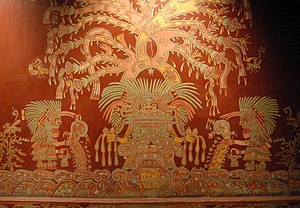
Religion
The religion of Teotihuacan was similar to those of other Mesoamerican cultures. Many of the same gods were worshiped, including the Feathered Serpent (the Aztecs' Quetzalcoatl) and Rain God (the Aztecs' Tlaloc.)[17] The dominant civic architecture is the pyramid. Politics were based on the state religion; religious leaders were the political leaders.[18]
Teotihuacanos practiced human sacrifice: human bodies and animal sacrifices have been found during excavations of the pyramids at Teotihuacan. Scholars believe that the people offered human sacrifices as part of a dedication when buildings were expanded or constructed. The victims were probably enemy warriors captured in battle and brought to the city for ritual sacrifice to ensure the city could prosper.[19] Some men were decapitated, some had their hearts removed, others were killed by being hit several times over the head, and some were buried alive. Animals that were considered sacred and represented mythical powers and military were also buried alive, imprisoned in cages: cougars, a wolf, eagles, a falcon, an owl, and even venomous snakes.[20]
Archaeological site
Knowledge of the huge ruins of Teotihuacan was never lost. After the fall of the city, various squatters lived on the site. During Aztec times, the city was a place of pilgrimage and identified with the myth of Tollan, the place where the sun was created. Teotihuacan astonished the Spanish conquistadores during the post-conquest era. Today Teotihuacan is one of the most noted archaeological attractions in Mexico.
Excavations and investigations
In the late 1600s Carlos de Sigüenza y Góngora did some excavations around the Pyramid of the Sun [21]. Minor archaeological excavations were conducted in the 19th century. In 1905 archaeologist Leopoldo Batres led a major project of excavation and restoration. The Pyramid of the Sun was restored to celebrate the centennial of Mexican War of Independence in 1910. Excavations at the Ciudadela were carried out in the 1920s, supervised by Manuel Gamio. Other sections of the site were excavated in the 1940s and 50s. The first site-wide project of restoration and excavation was carried out by INAH from 1960–65 and supervised by Jorge Acosta. This had the goals of clearing the Avenue of the Dead, consolidating the structures facing it, and excavating the Palace of Quetzalpapalotl.
During the installation of a "sound and light" show in 1971, workers discovered the entrance to a tunnel and cave system underneath the Pyramid of the Sun.[22] Although scholars long thought it to be a natural cave, more recent examinations have established the tunnel was entirely manmade.[23] The interior of Pyramid of the Sun has never been fully excavated [citation needed].
In 1980-1982, another major program of excavation and restoration was carried out at the Pyramid of the Feathered Serpent and the Avenue of the Dead complex. Most recently, a series of excavations at the Pyramid of the Moon have greatly expanded evidence of cultural practices.
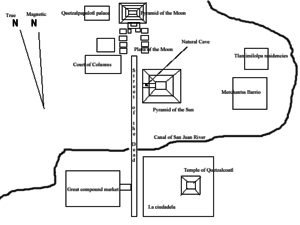
Site layout
The city's broad central avenue, called "Avenue of the Dead" (a translation from its Nahuatl name Miccoatli), is flanked by impressive ceremonial architecture, including the immense Pyramid of the Sun (second largest in the New World after the Great Pyramid of Cholula) and the Pyramid of the Moon. Along the Avenue of the Dead are many smaller talud-tablero platforms. The Aztecs believed they were tombs, inspiring the name of the avenue. Now scholars have established these were ceremonial platforms that were topped with temples.[citation needed]
Further down the Avenue of the Dead is the area known as the Citadel, containing the ruined Temple of the Feathered Serpent. This area was a large plaza surrounded by temples that formed the religious and political center of the city. The name "Citadel" was given to it by the Spanish, who believed it was a fort. Most of the common people lived in large apartment buildings spread across the city. Many of the buildings contained workshops where artisans produced pottery and other goods.
The geographical layout of Teotihuacan is a good example of the Mesoamerican tradition of planning cities, settlements and buildings as a representation of the view of the Universe. Its urban grid is aligned to precisely 15.5º east of North. One theory says this is due to the fact that the sun rose at that same angle during the same summer day each year. Settlers used the alignment to calibrate their sense of time or as a marker for planting crops or performing certain rituals. Another theory is that there are numerous ancient sites in Mesoamerica that seem to be oriented with the tallest mountain in their given area. This appears to be the case at Teotihuacan, although the mountain to which it is oriented is not visible from within the Teotihuacan complex due to a closer mountain ridge.[24] Pecked-cross circles throughout the city and in the surrounding regions indicate how the people managed to maintain the urban grid over long distances. It also enabled them to orient the Pyramids to the distant mountain that was out of sight.
Threat from development
The archaeological park of Teotihuacan is under threat from development pressures. In 2004, the governor of Mexico state, Arturo Montiel, gave permission for Wal-Mart to build a large store in the third archaeological zone of the park.[25] According to Counterpunch.org, "[P]riceless artifacts uncovered during store construction were reportedly trucked off to a local dump and workers fired when they revealed the carnage to the press."
More recently, Teotihuacan has become the center of controversy over Resplandor Teotihuacano,[26] a proposed massive light and sound spectacular, which, according to Statesman.com "includes large metallic structures, 2,500 lights and three kilometers of cables."[27]

See also
- Spring equinox in Teotihuacán
- Balberta, a Teotihuacan trading partner on the Pacific Coast of Guatemala
- Cerro de la Estrella, a large Teotihuacano-styled pyramid in what is now part of Mexico City
- List of archaeoastronomical sites by country
- List of megalithic sites
- List of Mesoamerican pyramids
- Montana (Mesoamerican site), a Teotihuacan colony on the Pacific Coast of Guatemala
Gallery
-
Front view of the Pyramid of the Sun
-
Another view of the Pyramid of the Sun
-
Left side view of the Pyramid of the Sun
-
Model of the Teotihuacan site located at National Museum of Anthropology in Mexico City.
-
Jaguar painting
-
Marble mask, 3rd - 7th century
-
Serpentine mask, 3rd-6th century
-
Turquoise mask pendent, 3rd-6th
References
Notes
- ^ Millon (1993, p.34)
- ^ Mathews and Schele (1997, p.39)
- ^ Miller and Taube (1993, p.170)
- ^ Millon (1993, p.24)
- ^ Malmström (1978, p.105) gives an estimate of 50,000 to 200,000 inhabitants. Coe et al. (1986) says it "might lie between 125,000 and 250,000."
- ^ Braswell (2003, p.7)
- ^ "Mexico's Pyramid of Death". National Geographic. 2006. Retrieved 2008-02-26.
- ^ "Sacrificial Burial Deepens Mystery At Teotihuacan, But Confirms The City's Militarism". ScienceDaily. 2004. Retrieved 2008-02-26.
- ^ See for example Cheek (1977, passim.), who argues that much of Teotihuacan's influence stems from direct militaristic conquest.
- ^ See Laporte (2003, p.205); Varela Torrecilla and Braswell (2003, p.261).
- ^ Braswell (2003, p.11)
- ^ Braswell (2003, p.11); for the analysis at Tikal, see Laporte (2003, pp.200–205)
- ^ Davies, p. 78.
- ^ Kaufman (2001, p.4)
- ^ Terrence Kaufman, "Nawa linguistic prehistory", SUNY Albany
- ^ * Wright Carr, David Charles (2005). "El papel de los otomies en las culturas del altiplano central 5000 a.C - 1650 d.C". Arqueología mexicana. XIII (73): 19.
{{cite journal}}: templatestyles stripmarker in|author=at position 1 (help)CS1 maint: numeric names: authors list (link) Template:Es icon - ^ Coe (1994), p. 101.
- ^ Sugiyama: 111
- ^ Coe (1994), p. 98.
- ^ Sugiyama: 109, 111
- ^ http://www.milenio.com/node/501242 Tunnel under Pyramid of the Feathered Serpent under exploration in 2010
- ^ Heyden (1975, p.131)
- ^ Šprajc (2000, p.410)
- ^ "Teotihuacan History".
- ^ Ross, John (February 27 – March 1, 2009). "The World's Most Remarkable Buildings Under Threat". Counterpunch.org Weekend Edition.
{{cite news}}: CS1 maint: date format (link) - ^ http://www.resplandorteotihuacano.com/
- ^ Schwartz, Jeremy (January 8, 2009). "Light and sound show threatens to damage Teotihuacan pyramids". Statesman.com.
Bibliography
- Berrin, Kathleen (1993). Teotihuacan: Art from the City of the Gods. New York: Thames and Hudson. ISBN 0-500-23653-4. OCLC 28423003.
{{cite book}}: Unknown parameter|coauthors=ignored (|author=suggested) (help); templatestyles stripmarker in|author=at position 1 (help); templatestyles stripmarker in|coauthors=at position 5 (help)CS1 maint: numeric names: authors list (link) - Braswell, Geoffrey E. (2003). "Introduction: Reinterpreting Early Classic Interaction". In Geoffrey E. Braswell (Ed.) (ed.). The Maya and Teotihuacan: Reinterpreting Early Classic Interaction. Austin: University of Texas Press. pp. 1–44. ISBN 0-292-70587-5. OCLC 49936017.
{{cite book}}: templatestyles stripmarker in|author=at position 1 (help)CS1 maint: numeric names: authors list (link) - Brown, Dale M. (ed.) (1992). Aztecs: Reign of Blood and Splendor. Lost Civilizations series. Alexandria, VA: Time-Life Books. ISBN 0-809-49854-5. OCLC 24848419.
{{cite book}}:|author=has generic name (help); templatestyles stripmarker in|author=at position 1 (help)CS1 maint: numeric names: authors list (link) - Cheek, Charles D. (1977). "Excavations at the Palangana and the Acropolis, Kaminaljuyu". In William T. Sanders and Joseph W. Michels (Eds.) (ed.). Teotihuacan and Kaminaljuyu: a Study in Prehistoric Culture Contact. University Park: Pennsylvania State University Press. pp. 1–204. ISBN 0271005297. OCLC 3327234.
{{cite book}}: templatestyles stripmarker in|author=at position 1 (help)CS1 maint: numeric names: authors list (link) - Coe, Michael D. (1994) [1962]. Mexico: From the Olmecs to the Aztecs. New York: Thames & Hudson. ISBN 0-500-27722-2. OCLC 50131575.
{{cite book}}: Unknown parameter|coauthors=ignored (|author=suggested) (help); templatestyles stripmarker in|author=at position 1 (help); templatestyles stripmarker in|coauthors=at position 5 (help)CS1 maint: numeric names: authors list (link) - Coe, Michael D. (1986). Atlas of Ancient America. New York: Facts on File. ISBN 0-816-01199-0.
{{cite book}}: Unknown parameter|coauthors=ignored (|author=suggested) (help); templatestyles stripmarker in|author=at position 1 (help); templatestyles stripmarker in|coauthors=at position 1 (help)CS1 maint: numeric names: authors list (link) - Cowgill, George L. (1992). "Teotihuacan Glyphs and Imagery in the Light of Some Early Colonial Texts". In Janet Catherine Berlo (ed.) (ed.). Art, Ideology, and the City of Teotihuacan: A Symposium at Dumbarton Oaks, 8th and 9th October 1988. Washington, DC: Dumbarton Oaks Research Library and Collection. pp. 231–246. ISBN 0-88402-205-6. OCLC 25547129.
{{cite book}}:|editor=has generic name (help); templatestyles stripmarker in|author=at position 1 (help)CS1 maint: numeric names: authors list (link) - Cowgill, George (1997). "State and Society at Teotihuacan, Mexico". Annual Review of Anthropology. 26 (1). Palo Alto, CA: Annual Reviews Inc: 129–161. doi:10.1146/annurev.anthro.26.1.129. OCLC 202300854.
{{cite journal}}:|format=requires|url=(help); templatestyles stripmarker in|author=at position 1 (help)CS1 maint: numeric names: authors list (link) - Davies, Nigel (1982). The Ancient Kingdoms of Mexico. England: Penguin Books. ISBN 0-14-013587-1.
{{cite book}}: templatestyles stripmarker in|author=at position 1 (help)CS1 maint: numeric names: authors list (link) - Heyden, Doris (1975). "An Interpretation of the Cave underneath the Pyramid of the Sun in Teotihuacan, Mexico". American Antiquity. 40 (2). Menasha, WI: Society for American Archaeology: 131–147. doi:10.2307/279609. OCLC 1479302. Retrieved 2008-02-07.
{{cite journal}}: Cite has empty unknown parameter:|coauthors=(help); templatestyles stripmarker in|author=at position 1 (help)CS1 maint: numeric names: authors list (link) - Kaufman, Terrence (2001). "Nawa linguistic prehistory". Mesoamerican Language Documentation Project.
{{cite web}}: templatestyles stripmarker in|author=at position 1 (help)CS1 maint: numeric names: authors list (link) - Laporte, Juan Pedro (2003). "Architectural Aspects of Interaction Between Tikal and Teotihuacan during the Early Classic Period". In Geoffrey E. Braswell (Ed.) (ed.). The Maya and Teotihuacan: Reinterpreting Early Classic Interaction. Austin: University of Texas Press. pp. 199–216. ISBN 0-292-70587-5. OCLC 49936017.
{{cite book}}: templatestyles stripmarker in|author=at position 1 (help)CS1 maint: numeric names: authors list (link) - Malmström, Vincent H. (1978). "Architecture, Astronomy, and Calendrics in Pre-Columbian Mesoamerica" (PDF Reprinted). Journal for the History of Astronomy. 9: 105–116. Retrieved 2007-01-17.
{{cite journal}}: templatestyles stripmarker in|author=at position 1 (help)CS1 maint: numeric names: authors list (link) - Miller, Mary (1993). The Gods and Symbols of Ancient Mexico and the Maya: An Illustrated Dictionary of Mesoamerican Religion. London: Thames & Hudson. ISBN 0-500-05068-6. OCLC 27667317.
{{cite book}}: Unknown parameter|coauthors=ignored (|author=suggested) (help); templatestyles stripmarker in|author=at position 1 (help); templatestyles stripmarker in|coauthors=at position 5 (help)CS1 maint: numeric names: authors list (link) - Millon, René (1993). "The Place Where Time Began: An Archaeologist's Interpretation of What Happened in Teotihuacan History". In Berrin, Kathleen and Esther Pasztory (Eds.) (ed.). Teotihuacan: Art from the City of the Gods. New York: Thames and Hudson. pp. 16–43. ISBN 0-500-23653-4. OCLC 28423003.
{{cite book}}: templatestyles stripmarker in|author=at position 1 (help)CS1 maint: numeric names: authors list (link) - Schele, Linda (1998). The Code of Kings: The Language of Seven Sacred Maya Temples and Tombs. New York: Scribner. ISBN 0-684-80106-X. OCLC 37819972.
{{cite book}}: Unknown parameter|coauthors=ignored (|author=suggested) (help); templatestyles stripmarker in|author=at position 1 (help); templatestyles stripmarker in|coauthors=at position 5 (help)CS1 maint: numeric names: authors list (link) - Sugiyama, Saburo (2003). Governance and Polity at Classic Teotihuacan; in Julia Ann Hendon, Rosemary A. Joyce, "Mesoamerican archaeology". Wiley-Blackwell.
{{cite book}}: templatestyles stripmarker in|author=at position 1 (help)CS1 maint: numeric names: authors list (link) - Šprajc, Ivan; Sprajc, Ivan (2000). "Astronomical Alignments at Teotihuacan, Mexico". Latin American Antiquity. 11 (4). Washington, DC: Society for American Archaeology: 403–415. doi:10.2307/972004. Retrieved 2008-02-07.
{{cite journal}}: templatestyles stripmarker in|author=at position 1 (help)CS1 maint: numeric names: authors list (link) - Taube, Karl A. (2000). The Writing System of Ancient Teotihuacan (PDF). Ancient America series #1. Barnardsville, NC: Center for Ancient American Studies. OCLC 44992821.
{{cite book}}: templatestyles stripmarker in|author=at position 1 (help)CS1 maint: numeric names: authors list (link) - Varela Torrecilla, Carmen (2003). "Teotihuacan and Oxkintok: New Perspectives from Yucatán". In Geoffrey E. Braswell (Ed.) (ed.). The Maya and Teotihuacan: Reinterpreting Early Classic Interaction. Austin: University of Texas Press. pp. 249–272. ISBN 0-292-70587-5. OCLC 49936017.
{{cite book}}: Unknown parameter|coauthors=ignored (|author=suggested) (help); templatestyles stripmarker in|author=at position 1 (help); templatestyles stripmarker in|coauthors=at position 5 (help)CS1 maint: numeric names: authors list (link) - Weaver, Muriel Porter (1993). The Aztecs, Maya, and Their Predecessors: Archaeology of Mesoamerica (3rd ed.). San Diego: Academic Press. ISBN 0-012-63999-0.
{{cite book}}: templatestyles stripmarker in|author=at position 1 (help)CS1 maint: numeric names: authors list (link) - Webmoor, Timothy (2007). "Reconfiguring the Archaeological Sensibility: Mediating Heritage at Teotihuacan, Mexico" (online digital publication, in Symmetrical Archaeology [2005–, collaboratory directors T. Webmoor and C. Witmore]). PhD thesis. Stanford Humanities Lab/Metamedia, Stanford University. Retrieved 2008-06-02.
{{cite journal}}: Cite journal requires|journal=(help); templatestyles stripmarker in|author=at position 1 (help)CS1 maint: numeric names: authors list (link)
External links
- Teotihuacan Research Guide, academic resources and links, maintained by Temple University
- Teotihuacan Photo Gallery, by James Q. Jacobs
- Mesoamerican Photo Archives: Teotihuacan, by David Hixson








